Mapping the Knowledge of Research Trends in Sports Performance Asymmetries from 2015 to 2024: A Bibliometric Study and Analysis of the Most-Cited Papers
Abstract
1. Introduction
2. Materials and Methods
2.1. Design
2.2. Data Extraction
2.3. Eligibility Criteria
2.4. Data Analysis
3. Results
3.1. Evolution in the Number of Publications
3.2. Document Type
3.3. Citation Analysis
3.4. Authors’ Analysis
3.5. Keyword Analysis
3.6. Analysis of the Journals
3.7. Editorial Analysis
3.8. Knowledge Areas
3.9. Language and Country Analysis
3.10. Organizations
4. Discussion
4.1. Future Perspectives and Practical Applications
4.2. Limitations
5. Conclusions
Author Contributions
Funding
Institutional Review Board Statement
Informed Consent Statement
Data Availability Statement
Conflicts of Interest
References
- Maloney, S.J. The Relationship Between Asymmetry and Athletic Performance: A Critical Review. J. Strength Cond. Res. 2019, 33, 2579–2593. [Google Scholar] [CrossRef] [PubMed]
- Guiard, Y. Asymmetric Division of Labor in Human Skilled Bimanual Action: The Kinematic Chain as a Model. J. Mot. Behav. 1987, 19, 486–517. [Google Scholar] [CrossRef] [PubMed]
- Kalata, M.; Maly, T.; Hank, M.; Michalek, J.; Bujnovsky, D.; Kunzmann, E.; Zahalka, F. Unilateral and Bilateral Strength Asymmetry among Young Elite Athletes of Various Sports. Medicina 2020, 56, 683. [Google Scholar] [CrossRef] [PubMed]
- Díez, A.; Lozano, D.; Arjol-Serrano, J.; Mainber-Pardos, E.; Castillo, D.; Torrontegui-Duarte, M.; Nobari, H.; Jáen-Carrillo, D.; Lampre, M. Influence of Contextual Factors on Physical Demands and Technicaltactical Actions Regarding Playing Position in Professional Soccer Players. BMC Sports Sci. Med. Rehabil. 2021, 13, 157. [Google Scholar] [CrossRef]
- Becerra-Patiño, B.; Paucar-Uribe, J.; Martínez-Benítez, C.; Ávila-Martínez, J.; Sarria-Lozano, J. Analysis of Physical Variables as an Indicator of Performance in a Sample of Colombian Women’s Soccer Players: Influence of Being a Starter and a Non-Starter. J. Phys. Educ. Sport 2023, 23, 1481–1487. [Google Scholar] [CrossRef]
- Ojeda-Aravena, A.; Warnier-Medina, A.; Brand, C.; Morales-Zúñiga, J.; Orellana-Lepe, G.; Zapata-Bastias, J.; Tuesta, M. Relationship between Body Composition Asymmetry and Specific Performance in Taekwondo Athletes: A Cross-Sectional Study. Symmetry 2023, 15, 2087. [Google Scholar] [CrossRef]
- Ibáñez, S.J.; López-Sierra, P.; Hernández-Beltrán, V.; Feu, S. Is Basketball a Symmetrical Sport? Symmetry 2023, 15, 1336. [Google Scholar] [CrossRef]
- Espada, M.C.; Jardim, M.; Assunção, R.; Estaca, A.; Ferreira, C.C.; Pessôa Filho, D.M.; Verardi, C.E.L.; Gamonales, J.M.; Santos, F.J. Lower Limb Unilateral and Bilateral Strength Asymmetry in High-Level Male Senior and Professional Football Players. Healthcare 2023, 11, 1579. [Google Scholar] [CrossRef]
- Hart, N.H.; Nimphius, S.; Weber, J.; Spiteri, T.; Rantalainen, T.; Dobbin, M.; Newton, R.U. Musculoskeletal Asymmetry in Football Athletes: A Product of Limb Function over Time. Med. Sci. Sports Exerc. 2016, 48, 1379–1387. [Google Scholar] [CrossRef]
- Hernández-Hernández, E.; Montalvo-Espinosa, A.; García-de-Alcaraz, A. A Time-Motion Analysis of the Cross-Over Step Block Technique in Volleyball: Non-Linear and Asymmetric Performances. Symmetry 2020, 12, 1027. [Google Scholar] [CrossRef]
- Zukowski, M.; Herzog, W.; Jordan, M.J. Multi-Planar Jump Performance in Speed Skating Athletes: Investigating Interlimb Differences in an Asymmetrical Sport. Symmetry 2023, 15, 1007. [Google Scholar] [CrossRef]
- Arboix-Alió, J.; Buscà, B.; Busquets, A.; Aguilera-Castells, J.; de Pablo, B.; Montalvo, A.M.; Fort-Vanmeerhaeghe, A. Relationship between Inter-Limb Asymmetries and Physical Performance in Rink Hockey Players. Symmetry 2020, 12, 2035. [Google Scholar] [CrossRef]
- Šarabon, N.; Smajla, D.; Maffiuletti, N.A.; Bishop, C. Strength, Jumping and Change of Direction Speed Asymmetries in Soccer, Basketball and Tennis Players. Symmetry 2020, 12, 1664. [Google Scholar] [CrossRef]
- Pavlović, M.; Ogrinc, N.; Šarabon, N. Body Asymmetries as Risk Factors for Musculoskeletal Injuries in Dancesport, Hip-Hop and Ballet Dancers? Eur. J. Transl. Myol. 2022, 32, 11020. [Google Scholar] [CrossRef]
- Dos’Santos, T.; Thomas, C.; Jones, P.A. Assessing Interlimb Asymmetries: Are We Heading in the Right Direction? Strength Cond. J. 2021, 43, 91–100. [Google Scholar] [CrossRef]
- Guan, Y.; Bredin, S.S.D.; Taunton, J.; Jiang, Q.; Wu, N.; Warburton, D.E.R. Association between Inter-Limb Asymmetries in Lower-Limb Functional Performance and Sport Injury: A Systematic Review of Prospective Cohort Studies. J. Clin. Med. 2022, 11, 360. [Google Scholar] [CrossRef] [PubMed]
- Moreno-Azze, A.; Prad-Lucas, E.; Fandos Soñén, D.; Pradas de la Fuente, F.; Falcón-Miguel, D. Plyometric Training’s Effects on Young Male Karatekas’ Jump, Change of Direction, and Inter-Limb Asymmetry. Sports 2023, 12, 1. [Google Scholar] [CrossRef]
- Markovic, G.; Šarabon, N.; Pausic, J.; Hadžić, V. Adductor Muscles Strength and Strength Asymmetry as Risk Factors for Groin Injuries among Professional Soccer Players: A Prospective Study. Int. J. Environ. Res. Public Health 2020, 17, 4946. [Google Scholar] [CrossRef]
- Arundale, A.J.H.; Kvist, J.; Hägglund, M.; Fältström, A. Jump performance in male and female football players. Knee Surg. Sports Traumatol. Arthrosc. 2020, 28, 606–613. [Google Scholar] [CrossRef]
- Kotsifaki, R.; Sideris, V.; King, E.; Bahr, R.; Whiteley, R. Performance and Symmetry measures During Vertical Jump Testing at Return to Sport after ACL Reconstruction. Br. J. Sports Med. 2023, 57, 1304–1310. [Google Scholar] [CrossRef]
- Brunst, C.; Ithurburn, M.P.; Zbojniewicz, A.M.; Paterno, M.V.; Schmitt, L.C. Return-To-Sport Quadriceps Strength Symmetry Impacts 5-year Cartilage Integrity After Anterior Cruciate Ligament Reconstruction: A Preliminary Analysis. J. Orthop. Res. 2022, 40, 285–294. [Google Scholar] [CrossRef] [PubMed]
- Glattke, K.E.; Tummala, S.V.; Chhabra, A. Anterior Cruciate Ligament Reconstruction Recovery and Rehabilitation: A Systematic Review. J. Bone Jt. Surg. Am. 2022, 104, 739–754. [Google Scholar] [CrossRef]
- White, K.; Di Stasi, S.L.; Smith, A.H.; Snyder-Mackler, L. Anterior Cruciate Ligament- Specialized Post-Operative Return-to-Sports (ACL-SPORTS) Training: A Randomized Control Trial. BMC Musculoskelet. Disord 2013, 14, 108. [Google Scholar] [CrossRef]
- Evans, R.J.; Moffit, T.J.; Mitchell, P.K.; Pamukoff, D.N. Injury and Performance Related Biomechanical Differences Between Recreational and Collegiate Runners. Front. Sports Act Living 2023, 5, 1268292. [Google Scholar] [CrossRef]
- Banks, J.J.; Umberger, B.R.; Boyer, K.A.; Caldwell, G.E. Lower Back Kinetic Demands During Induced Lower Limb Gait Asymmetries. Gait Posture 2022, 98, 101–108. [Google Scholar] [CrossRef]
- Miles, J.J.; McGuigan, P.M.; King, E.; Daniels, K.A.J. Biomechanical Asymmetries differ between Autograft types During Unplanned Change of Direction after ACL Reconstruction. Scand. J. Med. Sci. Sports 2022, 32, 1236–1248. [Google Scholar] [CrossRef]
- Kotsifaki, A.; Van Rossom, S.; Whiteley, R.; Korakakis, V.; Bahr, R.; Sideris, V.; Jonkers, I. Single Leg Vertical Jump Performance Identifies Knee Function Deficits at Return to Sport after ACL Reconstruction in Male Athletes. Br. J. Sports Med. 2022, 56, 490–498. [Google Scholar] [CrossRef]
- Girard, O.; Racinais, S.; Couderc, A.; Morin, J.B.; Ryu, J.H.; Piscione, J.; Brocherie, F. Asymmetries during Repeated Treadmill Sprints in Elite Female Rugby Sevens Players. Sports Biomech. 2023, 22, 863–873. [Google Scholar] [CrossRef]
- Sanchez-Sanchez, J.; Rodriguez-Fernandez, A.; Granacher, U.; Afonso, J.; Ramirez-Campillo, R. Plyometric Jump Training Effects on Maximal Strength in Soccer Players: A Systematic Review with Meta-analysis of Randomized-Controlled Studies. Sports Med.-Open 2024, 10, 52. [Google Scholar] [CrossRef]
- Sammoud, S.; Negra, Y.; Bouguezzi, R.; Ramirez-Campillo, R.; Moran, J.; Bishop, C.; Chaabene, H. Effects of Plyometric Jump Training on Measures of Physical Fitness and Lower-Limb Asymmetries in Prepubertal Male Soccer Players: A Randomized Controlled trial. BMC Sports Sci. Med. Rehabil. 2024, 16, 37. [Google Scholar] [CrossRef]
- Bishop, C.; Turner, A.; Maloney, S.; Lake, J.; Loturco, I.; Bromley, T.; Read, P. Drop Jump Asymmetry is Associated with Reduced Sprint and Change-of-Direction Speed Performance in Adult Female Soccer Players. Sports 2019, 7, 29. [Google Scholar] [CrossRef] [PubMed]
- Fox, K.T.; Pearson, L.T.; Hicks, K.M. The Effect of Lower Inter-Limb Asymmetries on Athletic Performance: A systematic Review and Meta-Analysis. PLoS ONE 2023, 18, e0286942. [Google Scholar] [CrossRef]
- Blagrove, R.C.; Bishop, C.; Howatson, G.; Hayes, P.R. Inter-limb Strength Asymmetry in Adolescent Distance Runners: Test-Retest Reliability and Relationships with Performance and Running Economy. J. Sports Sci. 2020, 39, 312–321. [Google Scholar] [CrossRef]
- Bishop, C.; Brashill, C.; Abbott, W.; Read, P.; Lake, J.; Turner, A. Jumping Asymmetries Are Associated with Speed, Change of Direction Speed, and Jump Performance in Elite Academy Soccer Players. J. Strength Cond. Res. 2021, 35, 1841–1847. [Google Scholar] [CrossRef] [PubMed]
- Nicholson, G.; Bennett, T.; Thomas, A.; Pollitt, L.; Hopkinson, M.; Crespo, R.; Robinson, T.; Price, R.J. Inter-limb Asymmetries and Kicking Limb Preference in English Premier League Soccer Players. Front. Sports Act. Living 2022, 4, 982796. [Google Scholar] [CrossRef]
- Śliwowski, R.; Paillard, T.; Bojkowski, Ł.; Dudziński, W.; Patek, M.; Marynowicz, J. Intra- and Inter-Limb Strength Imbalance and Asymmetry in Soccer: A Comparison of Elite Senior and Junior Players. PLoS ONE 2024, 19, e0302474. [Google Scholar] [CrossRef]
- Eustace, S.J.; Page, R.M.; Greig, M. Angle-Specific Isokinetic Metrics Highlight Strength Training Needs of Elite Youth Soccer Players. J. Strength Cond. Res. 2020, 34, 3258–3265. [Google Scholar] [CrossRef]
- Paterno, M.V.; Schmitt, L.C.; Ford, K.R.; Rauh, M.J.; Myer, G.D.; Huang, B.; Hewett, T.E. Biomechanical Measures during Landing and Postural Stability Predict Second Anterior Cruciate Ligament Injury after Anterior Cruciate Ligament Reconstruction and Return to Sport. Am. J. Sports Med. 2010, 38, 1968–1978. [Google Scholar] [CrossRef]
- Bishop, C.; Turner, A.; Jarvis, P.; Chavda, S.; Read, P. Considerations for Selecting Field-Based Strength and Power Fitness Tests to Measure Asymmetries. J. Strength Cond. Res. 2017, 31, 2635–2644. [Google Scholar] [CrossRef]
- Bishop, C.; de Keijzer, K.L.; Turner, A.N.; Beato, M. Measuring Interlimb Asymmetry for Strength and Power: A Brief Review of Assessment Methods, Data Analysis, Current Evidence, and Practical Recommendations. J. Strength Cond. Res. 2023, 37, 745–750. [Google Scholar] [CrossRef]
- Bailey, C.A.; Sato, K.; McInnis, T.C. A Technical Report on Reliability Measurement in Asymmetry Studies. J. Strength Cond. Res. 2021, 35, 1779–1783. [Google Scholar] [CrossRef] [PubMed]
- Barrera-Domínguez, F.J.; Carmona-Gómez, A.; Tornero-Quiñones, I.; Sáez-Padilla, J.; Sierra-Robles, Á.; Molina-López, J. Influence of Dynamic Balance on Jumping-Based Asymmetries in Team Sport: A between-Sports Comparison in Basketball and Handball Athletes. Int. J. Environ. Res. Public Health 2021, 18, 1866. [Google Scholar] [CrossRef] [PubMed]
- Gribble, P.A.; Hertel, J.; Plisky, P. Using the Star Excursion Balance Test to Assess Dynamic Postural-Control Deficits and Outcomes in Lower Extremity Injury: A Literature and Systematic Review. J. Athl. Train. 2012, 47, 339–357. [Google Scholar] [CrossRef]
- Powden, C.J.; Dodds, T.K.; Gabriel, E.H. The Reliability of the Star Excursion Balance Test and Lower Quarter Y-Balance Test in Healthy Adults: A Systematic Review. Int. J. Sports Phys. Ther. 2019, 14, 683–694. [Google Scholar]
- Smith, C.A.; Chimera, N.J.; Warren, M. Association of y Balance Test Reach Asymmetry and Injury in Division I Athletes. Med. Sci. Sports Exerc. 2015, 47, 136–141. [Google Scholar] [CrossRef]
- Ruas, C.V.; Minozzo, F.; Pinto, M.D.; Brown, L.E.; Pinto, R.S. Lower-Extremity Strength Ratios of Professional Soccer Players according to Field Position. J. Strength Cond. Res. 2015, 29, 1220–1226. [Google Scholar] [CrossRef] [PubMed]
- Balsalobre-Fernández, C.; Xu, J.; Jarvis, P.; Thompson, S.; Tannion, K.; Bishop, C. Validity of a Smartphone App Using Artificial Intelligence for the Real-Time Measurement of Barbell Velocity in the Bench Press Exercise. J. Strength Cond. Res. 2023, 37, e640–e645. [Google Scholar] [CrossRef]
- Šarabon, N.; Kozinc, Ž.; Bishop, C. Comparison of Vertical and Horizontal Reactive Strength Index Variants and Association with Change of Direction Performance. J. Strength Cond. Res. 2023, 37, 84–90. [Google Scholar] [CrossRef]
- Fiorilli, G.; Mariano, I.; Iuliano, E.; Giombini, A.; Ciccarelli, A.; Buonsenso, A.; Calcagno, G.; di Cagno, A. Isoinertial Eccentric-Overload Training in Young Soccer Players: Effects on Strength, Sprint, Change of Direction, Agility and Soccer Shooting Precision. J. Sports Sci. Med. 2020, 19, 213–223. [Google Scholar]
- Barrio, E.D.; Thapa, R.K.; Villanueva-Flores, F.; Garcia-Atutxa, I.; Santibañez-Gutierrez, A.; Fernández-Landa, J.; Ramirez-Campillo, R. Plyometric Jump Training Exercise Optimization for Maximizing Human Performance: A Systematic Scoping Review and Identification of Gaps in the Existing Literature. Sports 2023, 11, 150. [Google Scholar] [CrossRef]
- Bishop, C.; Turner, A.; Read, P. Effects of Inter-Limb Asymmetries on Physical and Sports Performance: A Systematic Review. J. Sports Sci. 2018, 36, 1135–1144. [Google Scholar] [CrossRef] [PubMed]
- Passas, I. Bibliometric Analysis: The Main Steps. Encyclopedia 2024, 4, 1014–1025. [Google Scholar] [CrossRef]
- Hernández-Torrano, D.; Ho, Y.S. A Bibliometric Analysis of Publications in the Web of Science Category of Educational Psychology in the Last Two Decades. Psicol. Educ. 2021, 27, 101–113. [Google Scholar] [CrossRef]
- Brika, S.K.M.; Algamdi, A.; Chergui, K.; Musa, A.A.; Zouaghi, R. Quality of Higher Education: A Bibliometric Review Study. Front. Educ. 2021, 6, 666087. [Google Scholar] [CrossRef]
- Becerra Patiño, B.A.; Varón-Murcia, J.J.; Cárdenas-Contreras, S.; Castro-Malaver, M.A.; Ávila-Martínez, J.D. Scientific Production on the Relative Age Effect in Sport: Bibliometric Analysis of the Last 9 Years (2015–2023). Retos 2024, 52, 623–638. [Google Scholar] [CrossRef]
- Hernández-Beltrán, V.; Espada, M.C.; Muñoz-Jiménez, J.; León, K.; Ferreira, C.C.; Parraca, J.A.; Gamonales, J.M. Evolution of Documents Related to Biomechanics Research in Gymnastics. Biomechanics 2023, 3, 477–492. [Google Scholar] [CrossRef]
- Martínez Benítez, C.F.; Becerra-Patiño, B.; Rada-Perdigon, D.A. Mapping the research trend in the Web of Science on small-sided games in soccer: A Bibliometric study between 2010–2023. Retos 2024, 55, 363–378. [Google Scholar] [CrossRef]
- Salinas-Ríos, K.; García-López, A. Bibliometrics, A Useful Tool Within the Field of Research. J. Basic Appl. Psychol. Res. 2023, 3, 10–17. [Google Scholar] [CrossRef]
- Page, M.J.; Moher, D.; McKenzie, J.E. Introduction to PRISMA 2020 and Implications for Research Synthesis Methodologists. Res. Synth. Methods 2022, 13, 156–163. [Google Scholar] [CrossRef]
- Van Eck, N.J.; Waltman, L. Visualizing Bibliometric Networks. In Measuring Scholarly Impact; Ding, Y., Rousseau, R., Wolfram, D., Eds.; Springer International Publishing: Berlin/Heidelberg, Germany, 2014; pp. 285–320. [Google Scholar] [CrossRef]
- McAllister, J.T.; Lennertz, L.; Atencio Mojica, Z. Mapping a Discipline: A Guide to Using VOSviewer for Bibliometric and Visual Analysis. Sci. Technol. Libr. 2022, 41, 319–348. [Google Scholar] [CrossRef]
- Mukherjee, D.; Lim, W.M.; Kumar, S.; Donthu, N. Guidelines for advancing theory and practice through bibliometric research. J. Bus. Res. 2022, 148, 101–115. [Google Scholar] [CrossRef]
- Price, D.D.S. A general theory of bibliometric and other cumulative advantage processes. J. Am. Soc. Inf. Sci. 1976, 27, 292–306. [Google Scholar] [CrossRef]
- Coile, R.C. Lotka’s Frequency Distribution of Scientific Productivity. J. Am. Soc. Inf. Sci. 1977, 28, 366–370. [Google Scholar] [CrossRef]
- Vega-Muñoz, A.; Salazar-Sepúlveda, G.; Contreras-Barraza, N.; Araya-Silva, L. Scientific Mapping of Coastal Governance: Global Benchmarks and Trends. J. Mar. Sci. Eng. 2022, 10, 751. [Google Scholar] [CrossRef]
- Hirsch, J.E. An Index to Quantify an Individual’s Scientific Research Output. Proc. Natl. Acad. Sci. USA 2005, 102, 16569–16572. [Google Scholar] [CrossRef] [PubMed]
- Bufrem, L.; Prates, Y. Recorded Scientific Knowledge and Information Measuring Practices. CiÊNcia Da Informação 2005, 34, 9–25. [Google Scholar] [CrossRef]
- Impellizzeri, F.M.; Rampinini, E.; Maffiuletti, N.; Marcora, S.M. A Vertical Jump Force Test for Assessing Bilateral Strength Asymmetry in Athletes. Med. Sci. Sports Exerc. 2007, 39, 2044–2050. [Google Scholar] [CrossRef]
- Palmieri-Smith, R.M.; Lepley, L.K. Quadriceps Strength Asymmetry After Anterior Cruciate Ligament Reconstruction Alters Knee Joint Biomechanics and Functional Performance at Time of Return to Activity. Am. J. Sports Med. 2015, 43, 1662–1669. [Google Scholar] [CrossRef]
- Schmitt, L.C.; Paterno, M.V.; Ford, K.R.; Myer, G.D.; Hewett, T.E. Strength Asymmetry and Landing Mechanics at Return to Sport after Anterior Cruciate Ligament Reconstruction. Med. Sci. Sports Exerc. 2015, 47, 1426–1434. [Google Scholar] [CrossRef]
- Ithurburn, M.P.; Paterno, M.V.; Ford, K.R.; Hewett, T.E.; Schmitt, L.C. Young Athletes with Quadriceps Femoris Strength Asymmetry at Return to Sport After Anterior Cruciate Ligament Reconstruction Demonstrate Asymmetric Single-Leg Drop-Landing Mechanics. Am. J. Sports Med. 2015, 43, 2727–2737. [Google Scholar] [CrossRef]
- Zwolski, C.; Schmitt, L.C.; Quatman-Yates, C.; Thomas, S.; Hewett, T.E.; Paterno, M.V. The Influence of Quadriceps Strength Asymmetry on Patient-Reported Function at Time of Return to Sport After Anterior Cruciate Ligament Reconstruction. Am. J. Sports Med. 2015, 43, 2242–2249. [Google Scholar] [CrossRef]
- Bishop, C.; Read, P.; Lake, J.; Chavda, S.; Turner, A. Interlimb Asymmetries: Understanding How to Calculate Differences from Bilateral and Unilateral Tests. Strength Cond. J. 2018, 40, 1–6. [Google Scholar] [CrossRef]
- Gonzalo-Skok, O.; Tous-Fajardo, J.; Suarez-Arrones, L.; Arjol-Serrano, J.L.; Casajús, J.A.; Mendez-Villanueva, A. Single-Leg Power Output and Between-Limbs Imbalances in Team-Sport Players: Unilateral Versus Bilateral Combined Resistance Training. Int. J. Sports Physiol. Perform. 2017, 12, 106–114. [Google Scholar] [CrossRef] [PubMed]
- Bishop, C.; Lake, J.; Loturco, I.; Papadopoulos, K.; Turner, A.; Read, P. Interlimb Asymmetries: The Need for an Individual Approach to Data Analysis. J. Strength Cond. Res. 2021, 35, 695–701. [Google Scholar] [CrossRef] [PubMed]
- Helme, M.; Tee, J.; Emmonds, S.; Low, C. Does Lower-Limb Asymmetry Increase Injury Risk in Sport? A Systematic Review. Phys. Ther. Sport. 2021, 49, 204–213. [Google Scholar] [CrossRef] [PubMed]
- Heil, J.; Loffing, F.; Büsch, D. The Influence of Exercise-Induced Fatigue on Inter-Limb Asymmetries: A Systematic Review. Sports Med.-Open. 2020, 6, 39. [Google Scholar] [CrossRef]
- Parkinson, A.O.; Apps, C.L.; Morris, J.G.; Barnett, C.T.; Lewis, M.G.C. The Calculation, Thresholds and Reporting of Inter-Limb Strength Asymmetry: A Systematic Review. J. Sports Sci. Med. 2021, 20, 594–617. [Google Scholar] [CrossRef]
- Becerra Patiño, B.A.; Paucar-Uribe, J.D.; Montilla-Valderrama, V. Bibliometric Analysis of Plyometrics in Sport: 40 Years of Scientific Production. Retos 2024, 53, 183–195. [Google Scholar] [CrossRef]
- Benton, A.D.; Benton, D.C. Hamstring Rehabilitation Research: A Bibliometric Analysis of Themes, Authors, Countries and Journals. Int. J. Strength Cond. Res. 2022, 2, 1–17. [Google Scholar] [CrossRef]
- Desai, S.S.; Dent, C.S.; El-Najjar, D.B.; Swindell, H.W.; Popkin, C.A. Musculoskeletal Injury in American Football: A Bibliometric Analysis of the Most Cited Articles. Orthop. J. Sports Med. 2023, 11, 23259671231168875. [Google Scholar] [CrossRef]
- Khatra, O.; Shadgan, A.; Taunton, J.; Pakravan, A.; Shadgan, B. A Bibliometric Analysis of the Top Cited Articles in Sports and Exercise Medicine. Orthop. J. Sports Med. 2021, 9, 2325967120969902. [Google Scholar] [CrossRef] [PubMed]
- Cone, S.M.; Lee, S. Lower Limb Force Asymmetries During Landing and Jumping Exercises: A Pilot Study. Int. J. Exerc. Sci. 2021, 14, 544–551. [Google Scholar] [PubMed]
- Lin, J.; Shen, J.; Zhou, A.; Badicu, G.; Grosz, W.R. The Effects of Inter-Limb Asymmetry on Change of Direction Performance: A Systematic Review. Symmetry 2022, 14, 2177. [Google Scholar] [CrossRef]
- Afonso, J.; Peña, J.; Sá, M.; Virgile, A.; García-de-Alcaraz, A.; Bishop, C. Why Sports Should Embrace Bilateral Asymmetry: A Narrative Review. Symmetry 2022, 14, 1993. [Google Scholar] [CrossRef]
- Kalata, M.; Hank, M.; Bujnovsky, D.; Michalek, J.; Varjan, M.; Kunzmann, E.; Zahalka, F.; Maly, T. Bilateral Strength Asymmetry in Elite Youth Soccer Players: Differences between Age Categories. Symmetry 2021, 13, 1982. [Google Scholar] [CrossRef]
- Versic, S.; Pehar, M.; Modric, T.; Pavlinovic, V.; Spasic, M.; Uljevic, O.; Corluka, M.; Sattler, T.; Sekulic, D. Bilateral Symmetry of Jumping and Agility in Professional Basketball Players: Differentiating Performance Levels and Playing Positions. Symmetry 2021, 13, 1316. [Google Scholar] [CrossRef]
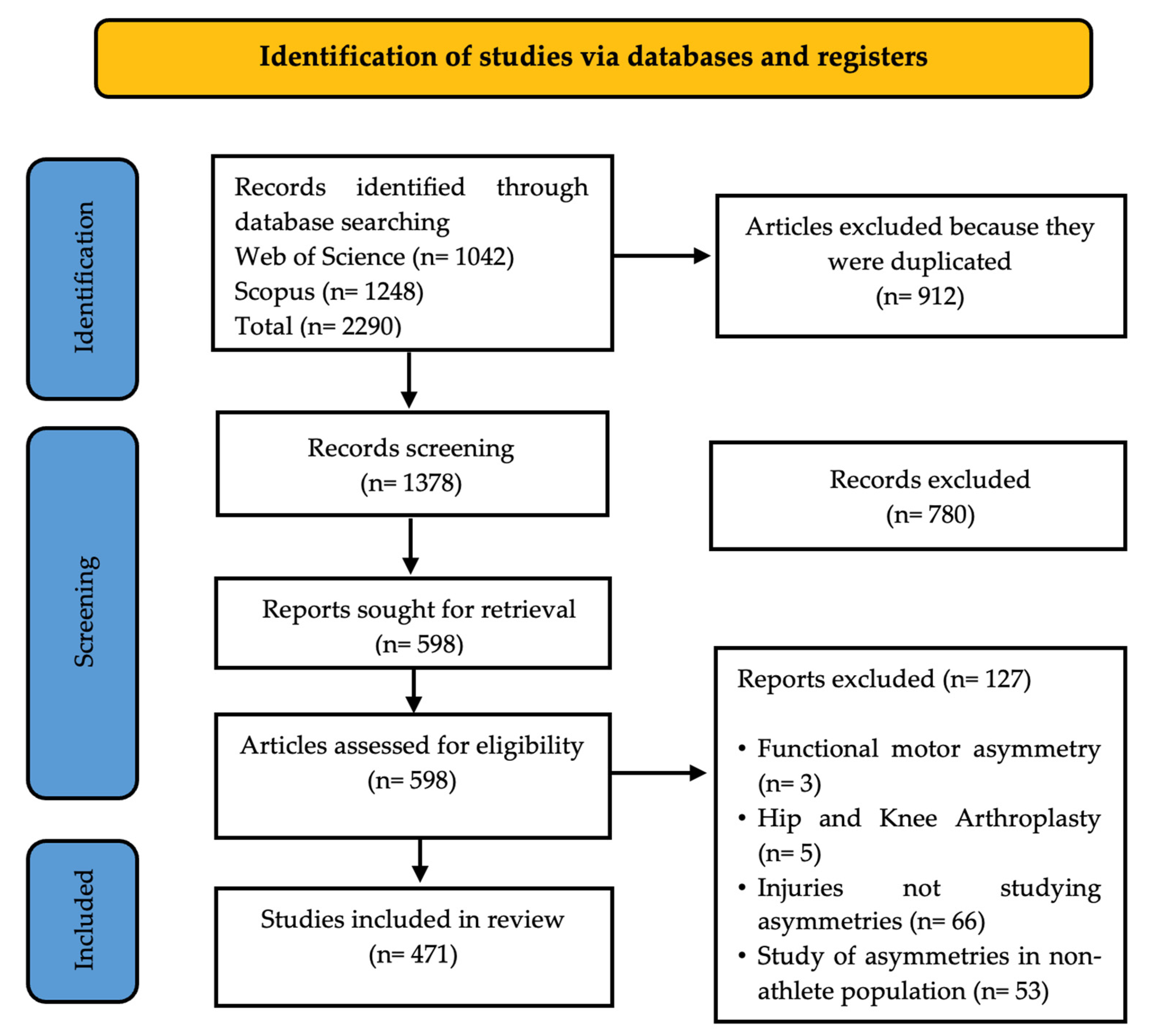
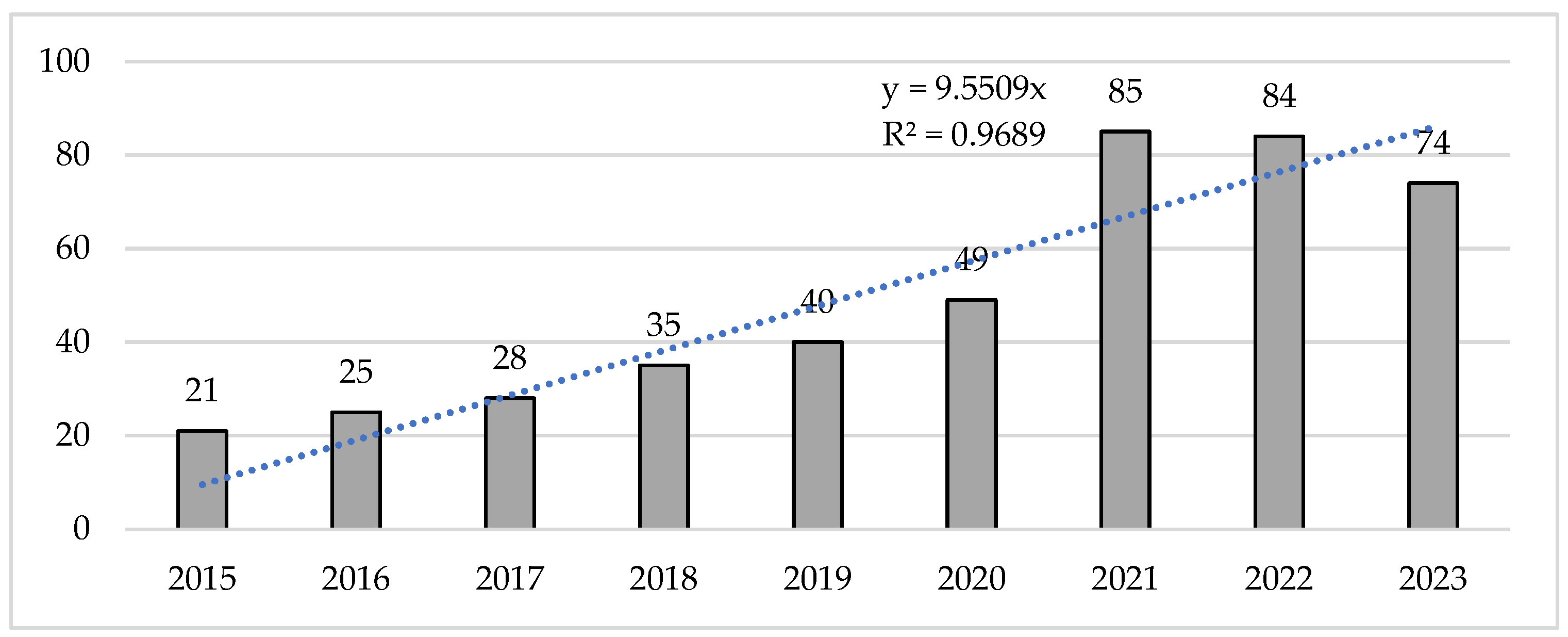
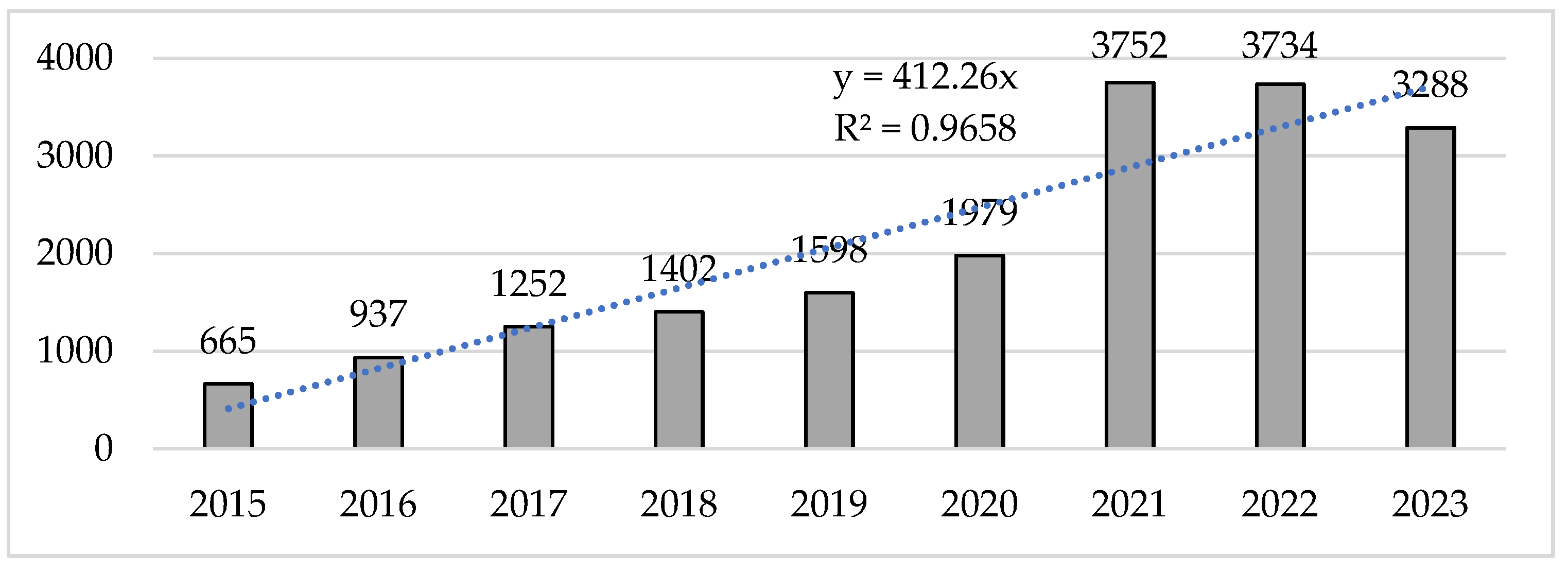
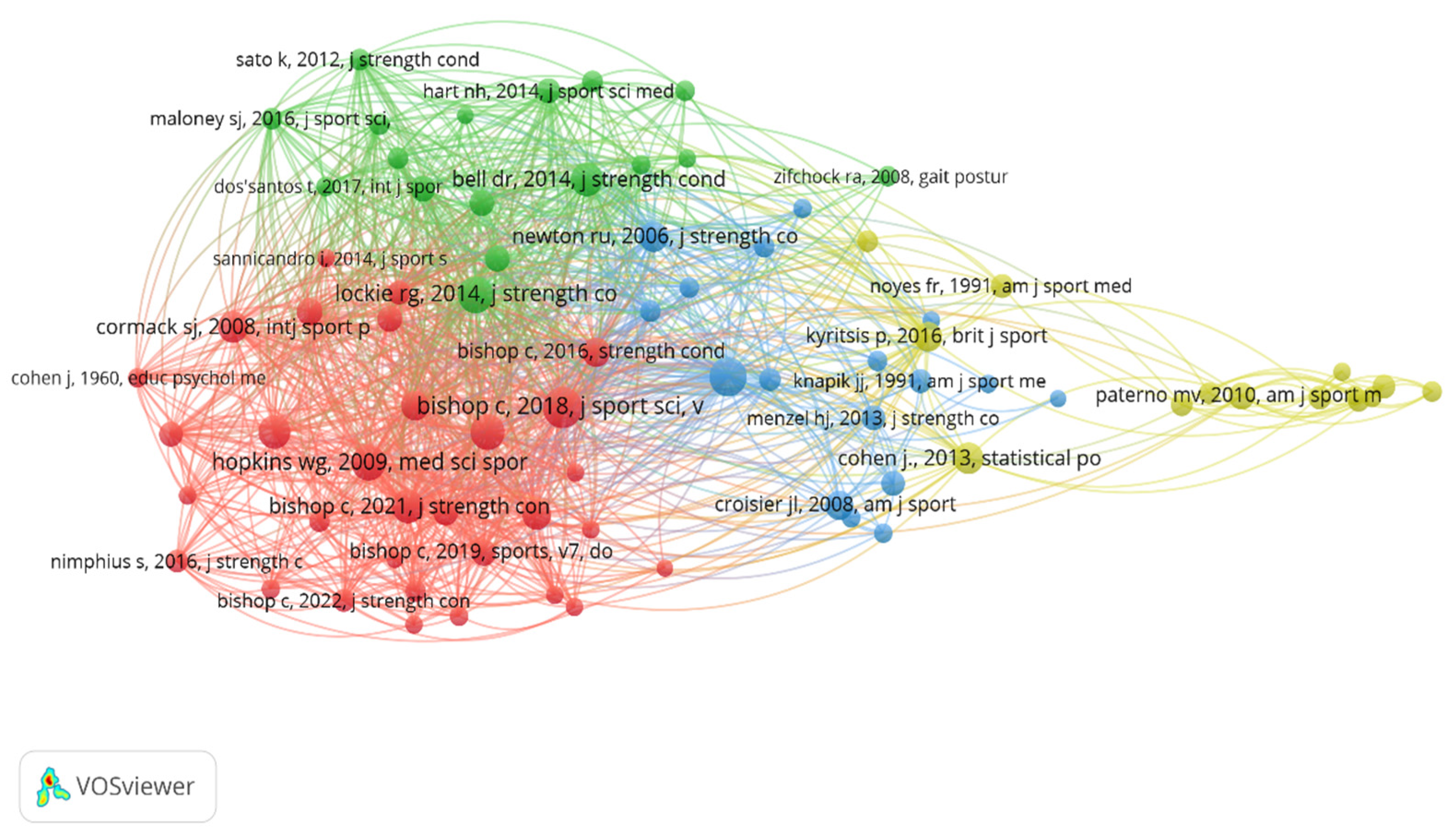
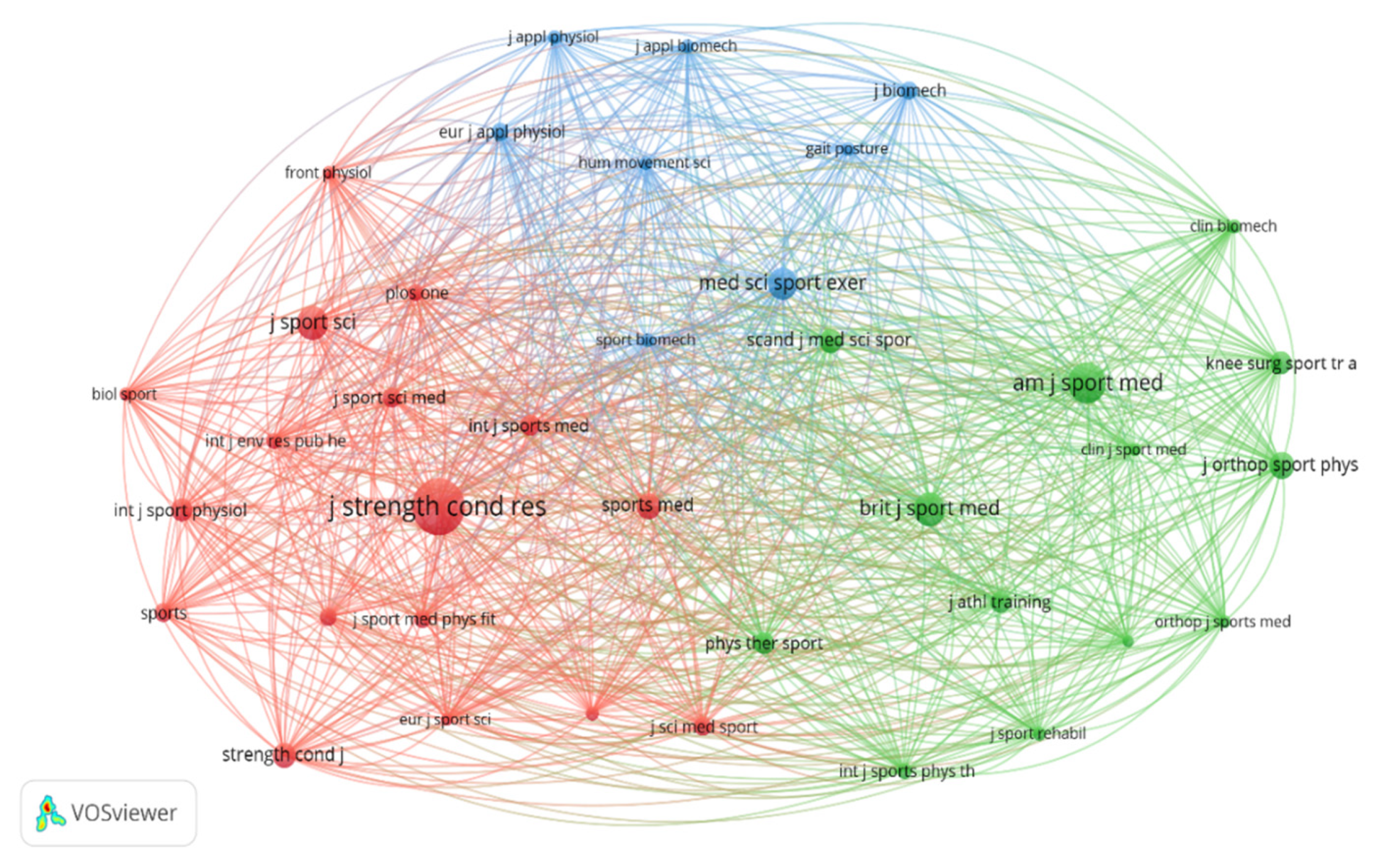
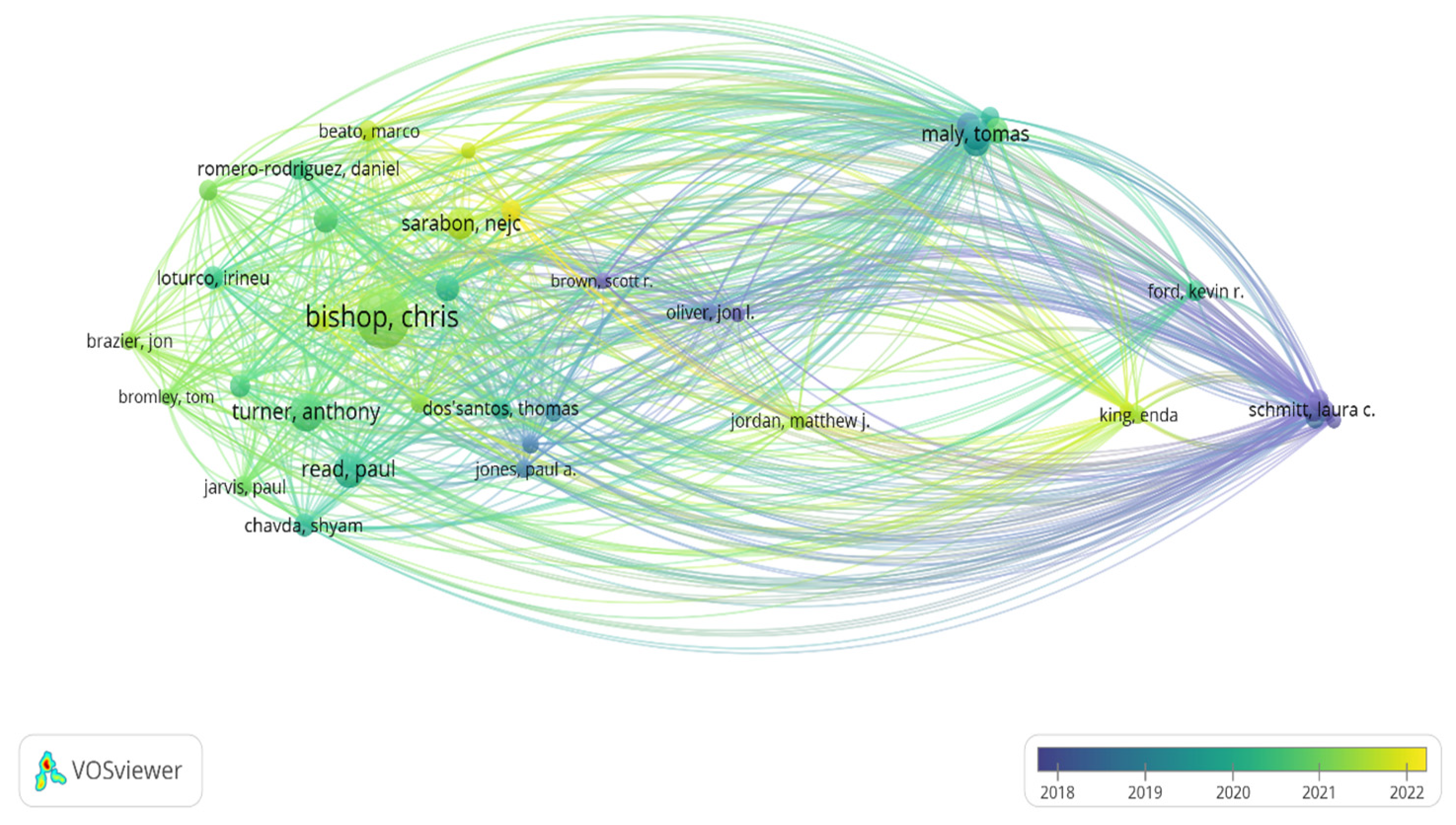
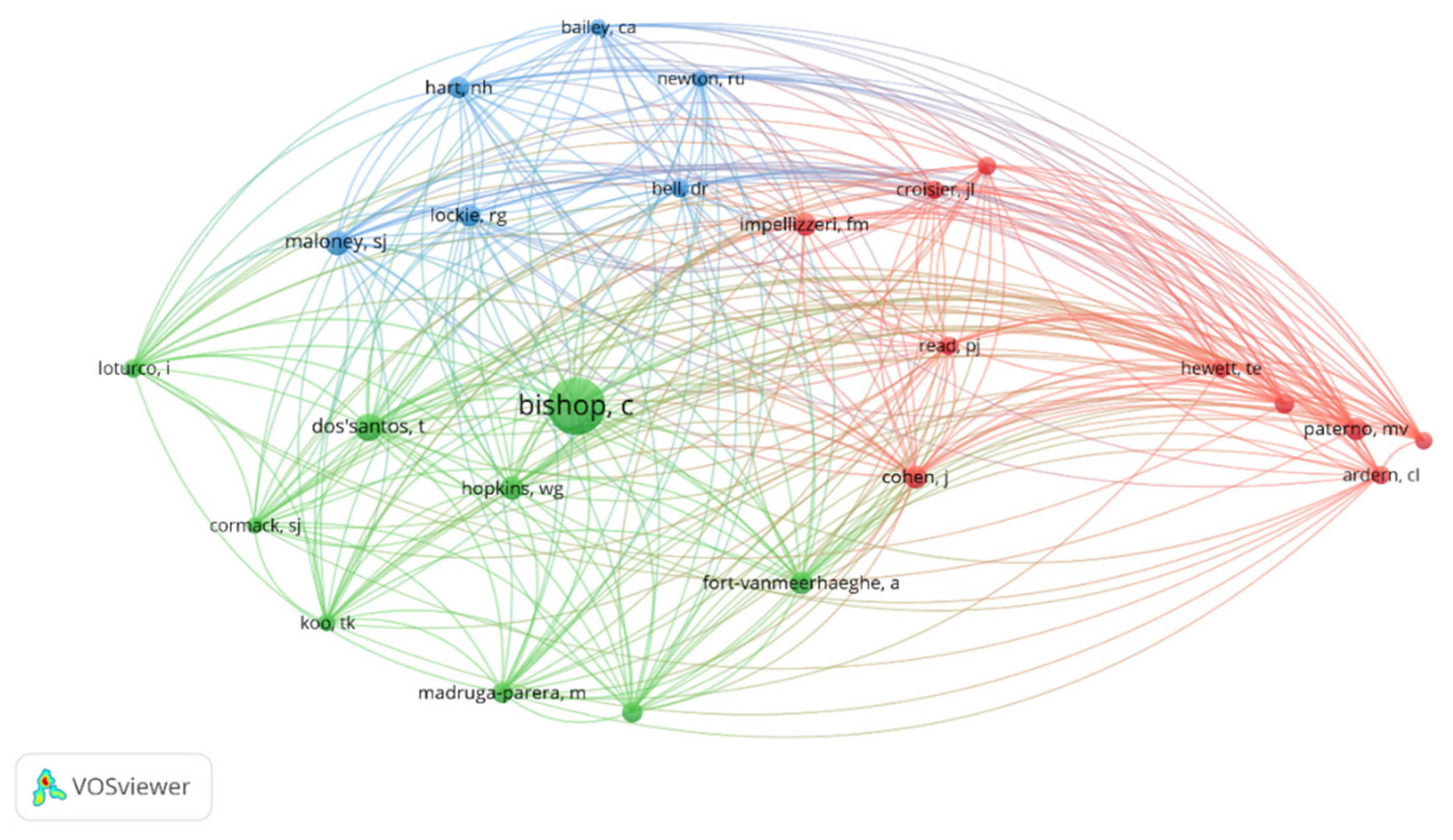
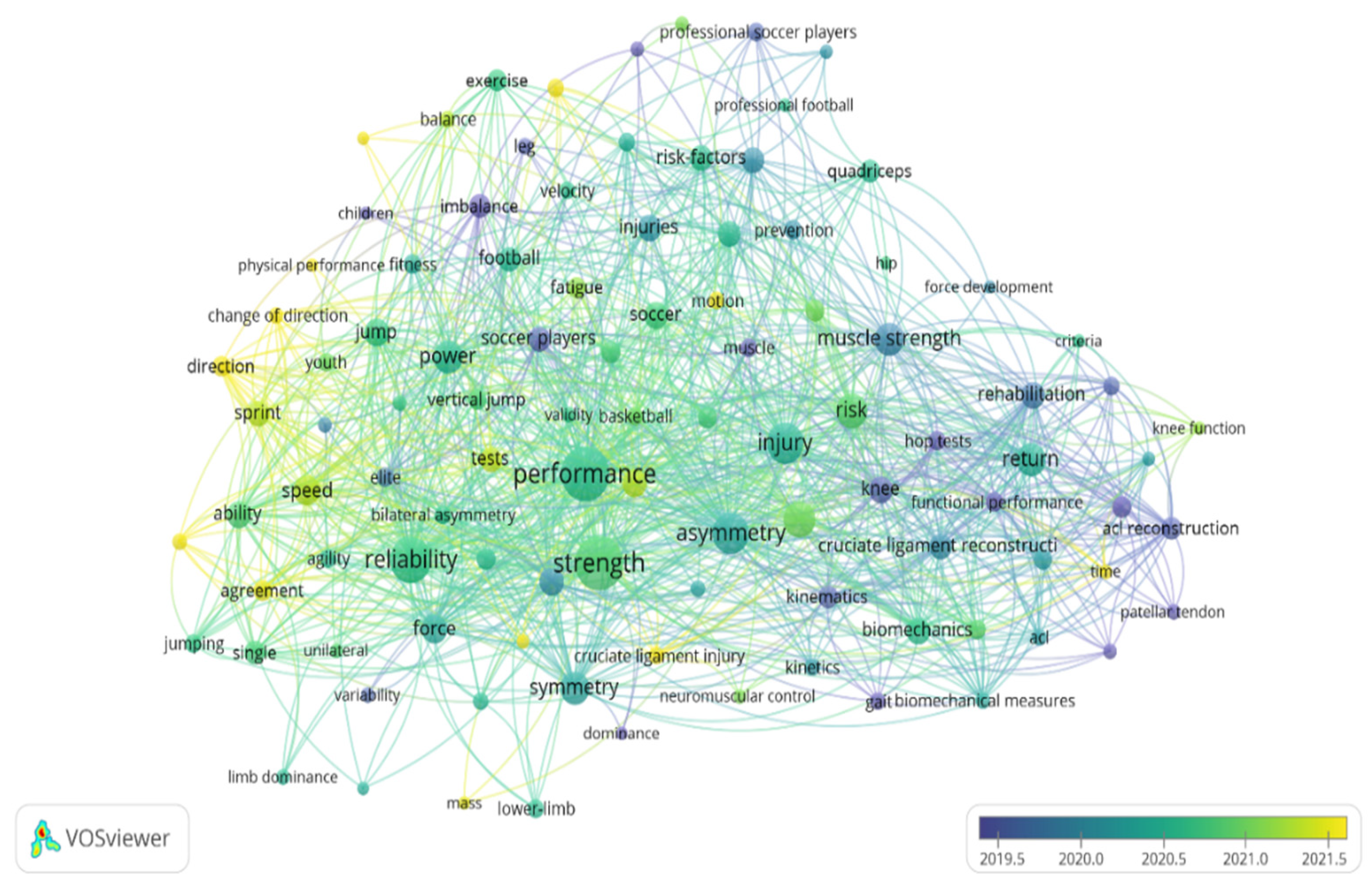
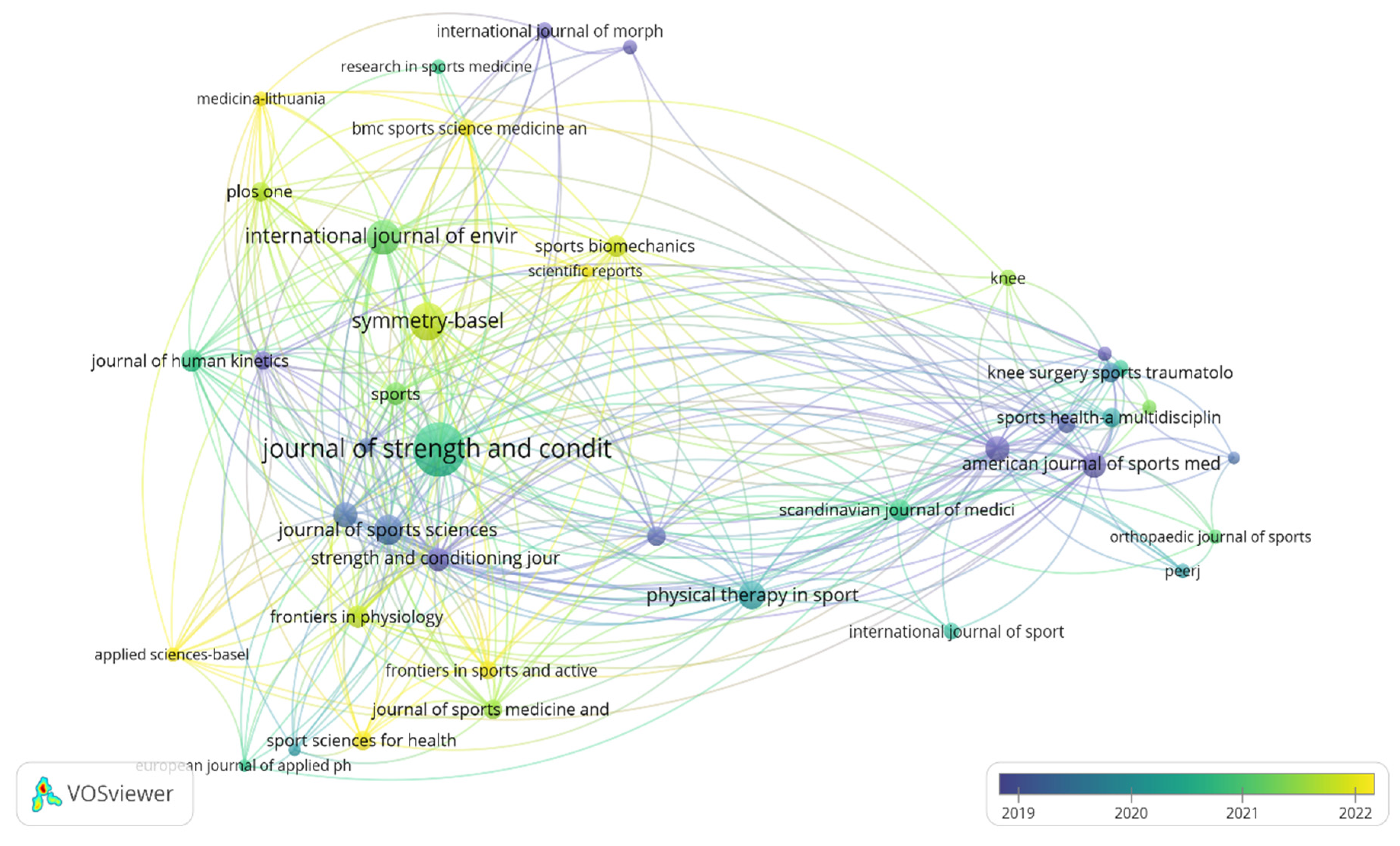
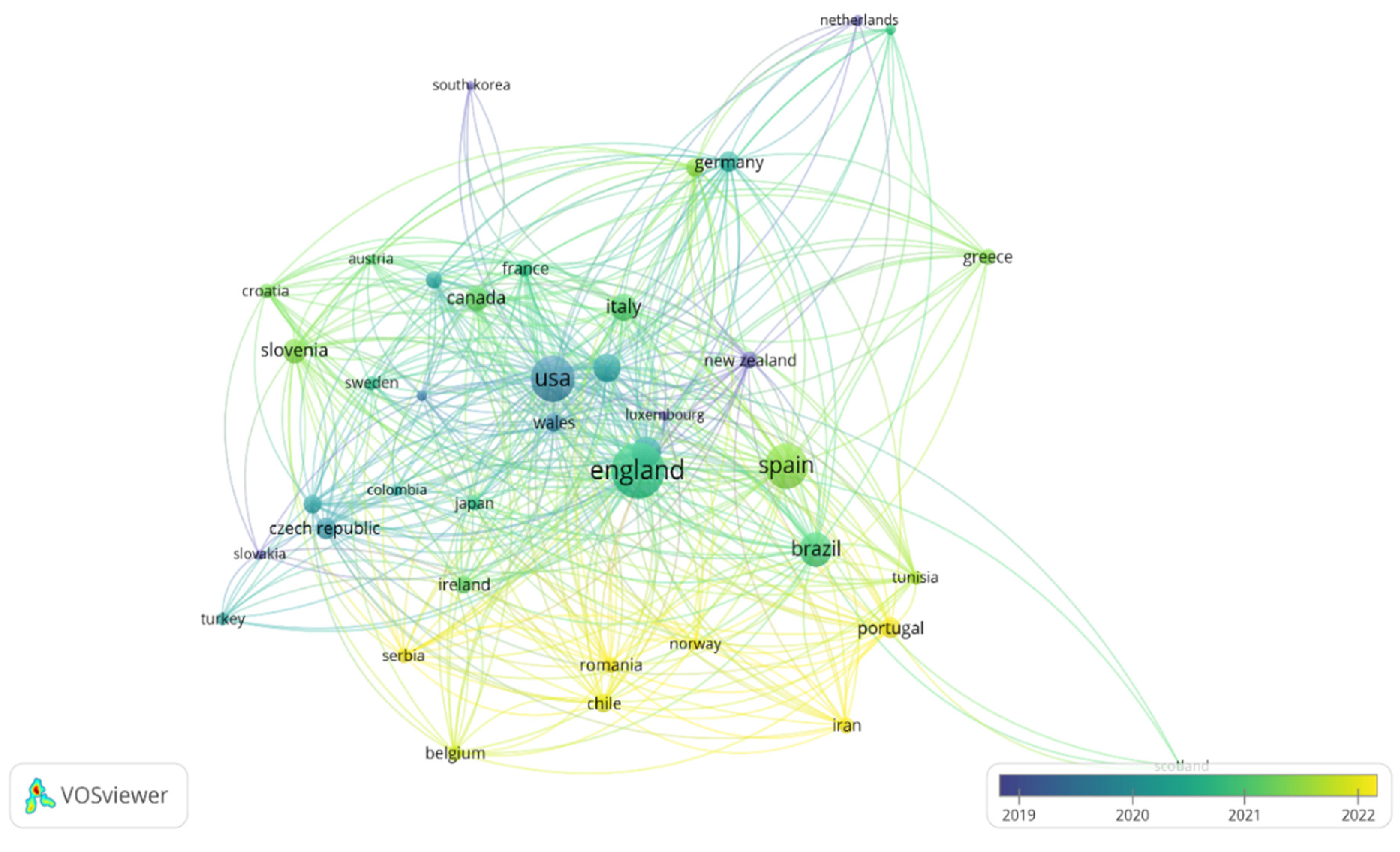
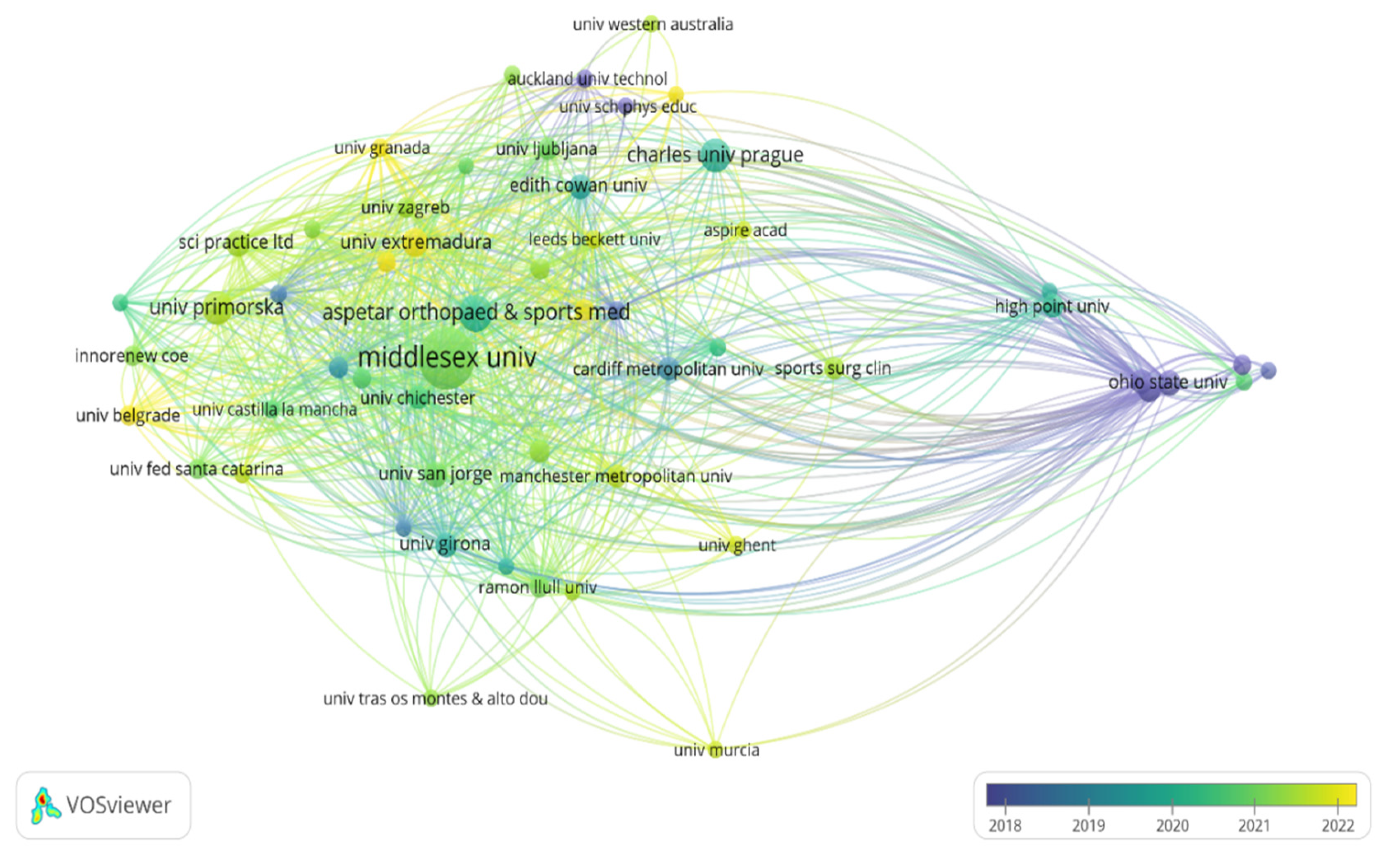
| Document Type | Record Count | % |
|---|---|---|
| Article | 440 | 93.41 |
| Review article | 20 | 4.24 |
| Meeting abstract | 8 | 1.69 |
| Letter | 2 | 0.42 |
| Retraction | 1 | 0.21 |
| Total | 471 | 100 |
| Authors and Year of Publication | Journal | Aim | Main Findings | Tot Cit | Ave per Year * |
|---|---|---|---|---|---|
| Bishop et al. [51]. | Journal of Sports Sciences | Analyze the effects of interlimb asymmetries on physical and sports performance. | Jump-based asymmetries are the least conclusive tests. These strength asymmetries appear to be associated with performance in specific actions, such as jumps, sport-specific skills, and CODs. | 248 | 41.33 |
| Maloney [1] | Journal of Strength and Conditioning Research | Determine the relationship between asymmetry and athletic performance. | Sports asymmetries allow for describing existing bilateral differences established based on parameters associated with force production and jump height. These asymmetries do not seem to influence the assessment of athletic performance, which is due to the different methodologies used. | 139 | 27.8 |
| Bishop et al. [39] | Journal of Strength and Conditioning Research | Analyze the utility of strength and jumping tests that are frequently used to measure asymmetry. | Measuring asymmetries based on jump strength is a justified evaluation in sports samples, although it is necessary to consider the concept of movement variability. This is because the assessment conducted between limbs in specific actions, such as jumping and other force applications, depends on the performed task. Unilateral or bilateral jump tests can be useful for detecting asymmetries. | 60 | 8.57 |
| Helme et al. [76] | Physical Therapy in Sports | Synthesize the current understanding of the relationship between lower body functional asymmetry and injury risk in athletic populations. | The quality of scientific production regarding functional asymmetries of the lower limbs is moderate-to-low. Tests used to evaluate functional asymmetry as a risk factor for sports injuries are limited by the diversity of approaches and the methodological rigor of the studies. It is suggested that professionals take these observations into account when implementing sports interventions. | 45 | 15 |
| Heil et al. [77] | Sports Medicine—Open | Provide an overview of the current state of evidence regarding the influence of exercise-induced fatigue on interlimb asymmetries through a systematic review. | It is suggested that pre–post designs should be used to evaluate asymmetries with sport specificity and, from there, carry out an observation process at specific moments to understand physical load. The incorporation of cutting or landing movements is suggested to more realistically represent the demands of the sport. It is unclear what protocol or task selection should be employed, as the study of asymmetries depends on the context and objective of the evaluation. | 33 | 8.25 |
| Parkinson et al. [78] | Journal of Sports Science and Medicine | (1) Assess the appropriateness of existing indices for calculating asymmetry, (2) examine the evidence supporting the thresholds used to define asymmetry in the literature, and (3) summarize normative levels of interlimb strength asymmetry and their effects on injury and performance. | There are unequal practices when quantifying or interpreting force asymmetry between limbs using threshold limits. The normalization of commonly accepted thresholds ranging from 10 to 15% should be avoided, as they lack scientific support. Therefore, professionals should interpret asymmetries with caution. | 24 | 8 |
| Authors and Year of Publication | Journal | Aim | Main Findings | Tot Cit | Ave per Year * |
|---|---|---|---|---|---|
| Palmieri-Smith et al. [69] | American Journal of Sports Medicine | Determine whether the magnitude of quadriceps strength asymmetry influences knee and hip biomechanical symmetry, as well as functional performance and self-reported function. | ACL reconstruction negatively influences movement symmetry in the sagittal plane and functional performance, due to the quadriceps’ isokinetic strength deficit. Additionally, quadriceps strength is related to greater jump performance and knee symmetry in the sagittal plane. This highlights the importance of quadriceps symmetrical strength in different rehabilitation programs to validate the return to sports activity. | 227 | 25.22 |
| Schmitt et al. [70] | Medicine and Science in Sport and Exercise | Investigate the effect of quadriceps femoris (QF) strength asymmetry on knee landing biomechanics at the time of return to sport after ACL reconstruction. | Quadriceps strength deficits after anterior cruciate ligament reconstruction are associated with altered knee mechanics in bilateral landings. Individuals with quadriceps strength deficits greater than 15% in the affected limb exhibit movement asymmetries in actions such as landing, and higher loading rates on the non-injured limb. | 205 | 22.77 |
| Ithurburn et al. [71] | American Journal of Sports Medicine | Evaluate the influence of musculoskeletal deficiencies on movement mechanics. | Restoring quadriceps strength symmetry after an ACL injury is related to more symmetrical mechanics in single-leg drop-landing actions. This improvement enhances postoperative athletic participation and reduces the risk of a new ACL injury. | 166 | 18.44 |
| Zwolski et al. [72] | American Journal of Sports Medicine | Determine whether the IKDC 2000 subjective knee form score at the time of RTS is a predictor of quadriceps strength in a young, athletic population after ACLR. | The International Knee Documentation Committee (IKDC) 2000 subjective knee form is an objective assessment of quadriceps strength after anterior cruciate ligament reconstruction, making it a necessary clinical measure to determine the process of preparation and reintegration of the athlete into practice. This is because isokinetic dynamometers are not always available to objectively quantify the existing limb symmetry in quadriceps strength. | 136 | 15.11 |
| Bishop et al. [73] | Strength and Conditioning Research | Provide a framework for selecting the most appropriate asymmetry equation based on the selected test method, ensuring accurate calculation and interpretation. | The quantification of asymmetries between limbs can be performed using unilateral and bilateral tests. However, when selecting bilateral tests, it is necessary to choose equations that allow differences between limbs to be established independently. The BAI-1 and SI appear to be the only formulas that will accurately quantify asymmetries during bilateral tasks. For the evaluation of unilateral tests, the BSA method or percentage difference is the most suitable. | 126 | 21 |
| Gonzalo-Skok et al. [74] | International Journal of Sports Physiology and Performance | Compare the effects of unilateral and bilateral resistance training on single-leg power output, BLI, BLD, COD, and linear sprinting and jumping performance in young elite basketball players. | Combined unilateral training had a positive effect on reducing asymmetries between limbs, which led to an improvement in actions requiring unilateral force application compared to bilateral training. Unilateral training also showed significant changes in variables such as jumping, linear sprint, and COD, making it important to incorporate this training exercise into weekly planning. | 106 | 15.14 |
| Bishop et al. [75] | Journal of Strength and Conditioning Research | Determine whether interlimb asymmetries always favor the same side for common metrics across unilateral strength and jumping-based tests. | DJ asymmetries were associated with reduced COD performance in professional cricket athletes, whereas no influence was reported among soccer players. The asymmetries evaluated in the lower limbs through the SLDJ test allowed for the specification of profiles according to sport specificity. Cricket athletes showed greater jump height and RSI asymmetries, which were associated with lower COD performance in both limbs. Meanwhile, soccer players had higher values in speed, jump height, and RSI. This demonstrates the importance of evaluating asymmetries in response to the specific demands of each sport and the individuality of athletes. | 105 | 35 |
| Author | H-Index | Number of Publications | % |
|---|---|---|---|
| Bishop, C. | 37 | 25 | 5.30 |
| Malý, T. | 17 | 8 | 1.69 |
| Fort-Vanmeerhaeghe, A. | 22 | 7 | 1.48 |
| Mala, L. | 14 | 6 | 1.27 |
| Madruga-Parera, M. | 13 | 6 | 1.27 |
| Brown, S.R. | 19 | 5 | 1.06 |
| Gonzalo-Skok, O. | 26 | 5 | 1.06 |
| Total | 62/471 | 13.16/100% |
| Number of Authors | Number of Publications | Percentage % |
|---|---|---|
| 1 to 2 | 35 | 7.43 |
| 3 to 5 | 237 | 50.31 |
| 6 to 8 | 171 | 36.30 |
| ≥9 | 28 | 5.94 |
| Total | 471 | 100% |
| Journal | Editorial | Country | Doc | Rank | JCI Category | Quartile | JCI | Num Cit * | Ave Num Cit Pub | |||
|---|---|---|---|---|---|---|---|---|---|---|---|---|
| J Strength Cond Res | Lip Will Wil | United States | 57 | 9/127 | Sport Sciences | Q1 | 1.62 | 1230 | 21.57 | |||
| Symmetry-Basel | MDPI | Switzerland | 27 | 34/135 | Multidisciplinary Sciences | Q2 | 0.86 | 118 | 4.37 | |||
| Int J Environ Res Public Health | MDPI | Switzerland | 23 | 85/325 | Environmental Sciences | Q2 | N/A | 175 | 7.60 | |||
| Journal of Sport Sciences | Taylor & Francis | United Kingdom | 17 | 31/127 | Sport Sciences | Q1 | 1.05 | 676 | 37.96 | |||
| Physical Therapy in Sport | United States | 15 | 37/127 | Sport Sciences | Q2 | 0.97 | 182 | 12.13 | ||||
| American Journal of Sports Medicine | Sage Publication | United States | 12 | 7/127 | Sport Sciences | Q1 | 1.83 | 871 | 72.58 | |||
| Int J Sports Physiol Perform | Human Kinetics | United States | 12 | 17/121 | Sport Sciences | Q1 | 1.27 | 298 | 24.83 | |||
| Med Sci Sports Exerc | Lip Will Wil | United States | 12 | 8/127 | Sport Sciences | Q1 | 1.74 | 359 | 29.91 | |||
| Stren Cond Res | Lip Will Wil | United States | 10 | 50/127 | Sport Sciences | Q2 | 0.86 | 338 | 33.80 | |||
| Sports | MDPI | Switzerland | 9 | 41/127 | Sport Sciences | Q2 | 0.91 | 186 | 20.66 | |||
| Journal of Human Kinetics | Termedia Publishing | Poland | 9 | 50/157 | Sport Sciences | Q2 | 0.86 | 143 | 15.88 | |||
| Frontiers in Physiology | Frontiers Media SA | Switzerland | 9 | 23/83 | Physiology | Q2 | 1.0 | 49 | 5.44 | |||
| Total: 12 Journals | Four countries | 212/471 | Four areas | Q1 | Q2 | Q3 | Q4 | 4625 | ||||
| 5 | 7 | 0 | 0 | |||||||||
| Editorial | Number of Documents | Total Citations |
|---|---|---|
| Lippincott Williams & Wilkins | 87 | 1974 |
| MDPI | 78 | 558 |
| Taylor & Francis | 39 | 842 |
| Sage Publication LTD | 28 | 1007 |
| Human Kinetics Publ Inc | 22 | 143 |
| Springer | 22 | 314 |
| Elsevier | 19 | 133 |
| Frontiers Media SA | 17 | 84 |
| Wiley | 12 | 182 |
| Edizion Minerva Medica | 10 | 32 |
| Total: 10 publishers | 334/471 | 5269 |
| Area * | Number of Publications | % |
|---|---|---|
| Sport Sciences | 220 | 46.70 |
| Orthopedics | 48 | 10.19 |
| Multidisciplinary Sciences | 43 | 9.12 |
| Rehabilitation | 31 | 6.58 |
| Physiology | 25 | 5.30 |
| Total: 5 areas | 367/471 | 77.91/100% |
Disclaimer/Publisher’s Note: The statements, opinions and data contained in all publications are solely those of the individual author(s) and contributor(s) and not of MDPI and/or the editor(s). MDPI and/or the editor(s) disclaim responsibility for any injury to people or property resulting from any ideas, methods, instructions or products referred to in the content. |
© 2025 by the authors. Licensee MDPI, Basel, Switzerland. This article is an open access article distributed under the terms and conditions of the Creative Commons Attribution (CC BY) license (https://creativecommons.org/licenses/by/4.0/).
Share and Cite
Becerra-Patiño, B.A.; Paucar-Uribe, J.D.; Olivares-Arancibia, J.; Ojeda-Aravena, A.; Yáñez-Sepúlveda, R.; Gamonales, J.M.; López-Gil, J.F.; Hernández-Beltrán, V. Mapping the Knowledge of Research Trends in Sports Performance Asymmetries from 2015 to 2024: A Bibliometric Study and Analysis of the Most-Cited Papers. Sports 2025, 13, 93. https://doi.org/10.3390/sports13040093
Becerra-Patiño BA, Paucar-Uribe JD, Olivares-Arancibia J, Ojeda-Aravena A, Yáñez-Sepúlveda R, Gamonales JM, López-Gil JF, Hernández-Beltrán V. Mapping the Knowledge of Research Trends in Sports Performance Asymmetries from 2015 to 2024: A Bibliometric Study and Analysis of the Most-Cited Papers. Sports. 2025; 13(4):93. https://doi.org/10.3390/sports13040093
Chicago/Turabian StyleBecerra-Patiño, Boryi A., Juan David Paucar-Uribe, Jorge Olivares-Arancibia, Alex Ojeda-Aravena, Rodrigo Yáñez-Sepúlveda, José M. Gamonales, José Francisco López-Gil, and Víctor Hernández-Beltrán. 2025. "Mapping the Knowledge of Research Trends in Sports Performance Asymmetries from 2015 to 2024: A Bibliometric Study and Analysis of the Most-Cited Papers" Sports 13, no. 4: 93. https://doi.org/10.3390/sports13040093
APA StyleBecerra-Patiño, B. A., Paucar-Uribe, J. D., Olivares-Arancibia, J., Ojeda-Aravena, A., Yáñez-Sepúlveda, R., Gamonales, J. M., López-Gil, J. F., & Hernández-Beltrán, V. (2025). Mapping the Knowledge of Research Trends in Sports Performance Asymmetries from 2015 to 2024: A Bibliometric Study and Analysis of the Most-Cited Papers. Sports, 13(4), 93. https://doi.org/10.3390/sports13040093













